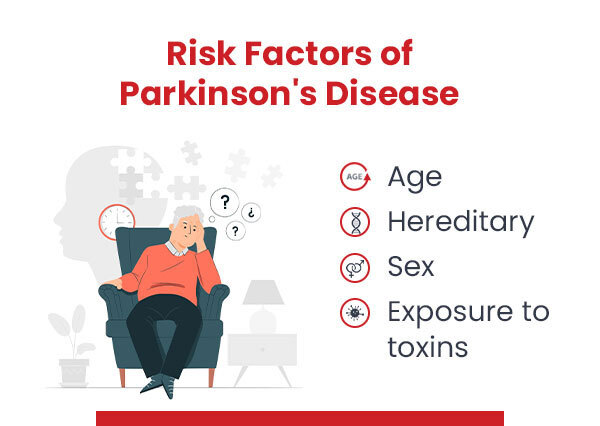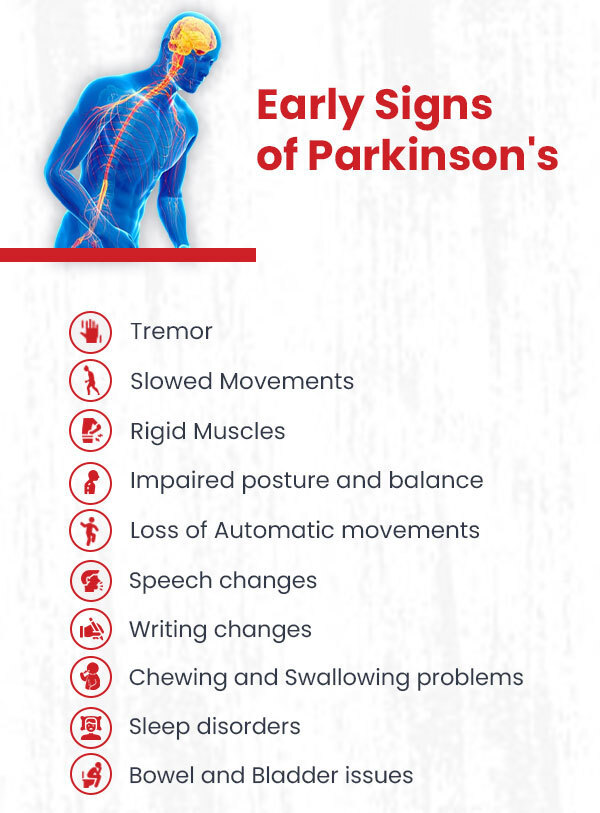About Parkinson’s
Parkinson’s disease is a progressive disorder of the central nervous system which causes unintended tremors and involuntary movements of the hands and legs along with difficulty in maintaining balance and coordination. In this type of disease, there is rapid breakdown or death of the neurons of the brain cells located in the part of the brain called SUBSTANTIA NIGRA. This causes depletion of an important chemical messenger called DOPAMINE which in turn causes atypical brain activity. This is the main reason for involuntary activities and other movement disorders.
Causes
Although the evident etiology of Parkinson’s is unknown, several other factors seem to play a role in the disease:
- Genetic factors: Certain genetic changes have shown to be a contributing factor towards developing Parkinson’s in case it runs in many members of the same family.
- Environmental factors: In a few cases, exposure to certain toxic chemicals has shown to be a contributing factor to developing Parkinson’s.
Types of Parkinson’s
- Idiopathic Parkinson’s is the most common form of Parkinson’s disease.
- Other forms of Atypical Parkinson’s disorders can be categorized under Parkinsonism
Multiple System Atrophy
- Combination of several neurodegenerative disorders in which one or the other systems in the body deteriorates.
- They show a poor response to medications for Parkinson’s disease
Progressive Supranuclear Palsy
- Uncommon brain disorder
- Causes problems with balance, coordination, walking, and eye movements
- Late
Corticobasal Syndrome
- Rare condition
- The disease affects the areas of the brain that process information and controls movement
- The brain cells of these areas die and shrink over time
- Causes poor coordination, stiffness, difficulty in thinking, and trouble with speech and language.
Dementia with Lewy bodies
- The most common type of asymptomatic Parkinson
- Rare in people under the age of 65
- Develops slowly and gradually worsens over the years
- The most common symptoms are confusion, hallucinations, sleeplessness
Drug-induced Parkinsonism
- Parkinsons caused by antipsychotic drugs are most commonly known as Drug-induced Parkinson’s
- Symptoms include tremors including resting tremors, muscle stiffness, slow gait movements, problems with posture and balance, and impaired speech.
Risk Factors

- Age: Parkinson’s disease generally develops in the middle or later age and the risk increases as age progresses.
- Hereditary: If many members of the same family have the disease then the risk increases genetically
- Sex: Men are more likely to develop the disease than women.
- Exposure to toxins: Frequent exposure to harmful toxins like pesticides increases the risk of developing the disease.
Early Signs of Parkinson’s

- Tremor: Rhythmic shaking or tremor begins in one limb and occurs maximum at rest and decreases while performing tasks.
- Slowed Movements (Bradykinesia): With time Parkinson’s makes movements difficult and time-consuming. Steps become shorter while walking.
- Rigid Muscles: Muscles at any part of the body start to become rigid and stiff thus making movements more difficult.
- Impaired posture and balance: Balance and coordination are disturbed in Parkinson’s and posture becomes stooped.
- Loss of Automatic movements: Movements that are automatic in nature such as blinking or swinging of arms while walking is restricted with the progression of the disease.
- Speech changes: Speech becomes sluggish and soft.
- Writing changes: Writing becomes slow and unrecognizable. Signatures start to get mismatched.
- Thinking difficulties, depression, and emotional changes.
- Chewing and Swallowing problems: As the condition progresses, the patient may experience difficulty in chewing food and swallowing due to decreased motor activities. Drooling may be persistent due to the accumulation of saliva in the mouth.
- Sleep disorders: Frequently waking up at night and having difficulty getting sound sleep is a common symptom of Parkinson
- Bowel and Bladder issues: Difficulty in controlling urine and severe constipation is a common features due to decreased motor activities.
Stages of Parkinson’s Disease
Based on Hoehn and Yard scale, Parkinson’s may be divided into five stages. Stages can be divided into non-motor and motor aspects of the development of the disease
- STAGE 1 – The disease is in its mildest form. Symptoms are almost never noticed.
- STAGE 2 – Progression from Stage 1 to 2 may take years. Muscle stiffness, tremors, and change in facial expressions are some of the prominent symptoms in this stage.
- STAGE 3 – Symptoms are more prominent and noticeable. Movements are slower and predominantly affect activities of daily living. Balance starts to get disturbed.
- STAGE 4 – Symptoms worsen to the extent that standing is not possible without assistance. Reactions are diminished. Living alone can be dangerous and unsafe.
- STAGE 5 – The patient is wheelchair-bound. Hallucinations, delusions, and confusions become prominent features.
Clinical Diagnosis
- The presence of three or four of the major symptoms is primarily enough to detect Parkinson’s.
- Diagnostics and lab tests are required to rule out any other neurological disorder present other than Parkinson’s.
A few of the tests done are:
- Single Photon Emission Computerised Topography (SPECT scan) mainly with the Dopamine Transporter Scan (DAT Scan) is the major physical test done to detect Parkinson’s.
- Blood tests
- Magnetic Resonance Imaging
- Positron Emission Tomography ( PET Scan )
Medical Management
- MEDICATIONS: There is no cure available for this progressive disorder. Medications help to manage the symptoms and act as a substitute for Dopamine. The most commonly used medication is Carbidopa – Levodopa.
- SURGICAL PROCEDURES: Deep Brain stimulation are surgical procedures in which surgeons implant electrodes into a part of the brain. This helps to control the adverse effects of Levodopa and manage movement disorders that do not improve with medications.
Prognosis of Parkinson’s
- Parkinson’s is a progressive disorder and so the disease progresses over time. However, the progression is slow and so a person can manage to live a normal life till a long time.
- Medications and Rehabilitation help manage the symptoms over time.
- Living independently after the disease progresses can become a challenge as medications and rehab tend to become less effective over time.
Is There a Cure for Parkinson’s
There is no cure available to date for Parkinson’s since it is progressive in nature. However, medications and rehabilitation help maintain the symptoms.
Difference Between Parkinson’s and Parkinsonism
| PARKINSONS |
PARKINSONISM |
| Caused by degeneration of brain cells in the brain. |
Causes can be numerous ranging from side effects of medications, chronic head trauma, metabolic disorders, etc. |
| Progressive in nature |
Limited to the clinical syndrome |
Rehabilitation for Parkinson’s Disease at MediGence
Parkinson’s is a progressive disorder of the brain which causes severe movement disorders. Systemic and customized rehabilitation delays the fast progression of the disease and helps maintain independent and productive longevity.
What do we deliver in our Parkinsons management:
Our programs include:
- Physical therapy: To decrease rigidity and maintain mobility
- Speech therapy: For swallowing and speech maintenance
- Cognitive and Behavioral Therapy: To decrease the fast progression of decline in cognitive abilities and thinking.
- Nutrition and diet management
- Counseling sessions with the primary caregivers in the family.
Expected Outcome:
We realize how important it is to reduce the fast progression of the disease and maintain an independent life
We not only aim to deliver comprehensive customized rehab protocols but also ensure that the patient re-habituates toward community living in the best possible manner.
- Maintaining activities of daily living
- Decrease in rigidity
- Maintaining balance and coordination
- Maintenance of speech
- Maintaining gait patterns
Life Expectancy Post Parkinson’s
Parkinson’s is not a fatal disease. However, complications may arise due to uncontrolled or untreated symptoms. These may lead to:
- Falls
- Blood clots
- Blockages in the lungs
- Lung infections
Living with a chronic progressive illness can be challenging at times but a few modifications in lifestyle along with medications and rehabilitation can maintain longevity without complications
Life Style Changes Post Parkinson’s
1. Healthy eating: Malnutrition and constipation are the main issues that arise in individuals with Parkinson’s. Some tips for healthy eating are:
- Stay hydrated
- High fibre food
- Antioxidants
- Avoid high-protein meals just before your medications. Spread it throughout the day.
2. Active lifestyle: By being active an individual with Parkinson’s can alleviate depression, anxiety, and stress which come naturally with chronic illnesses like this.
- Atleast three hours of physical activities divided over the week
- Regular walking has shown tremendous results in delaying the progression of the disease,
- Exercises should include aerobic activities, strength building, and stretching.
- Choose activities that you love
- Always interact with people with similar diseases and join group activities. This is a big mental booster.
3. Good Sleep: About 80 % of people with Parkinson’s develop sleep behavior disorders. Either they are highly drowsy due to the side effects of medicines or they have Insomnia (difficulty in staying asleep). Since sleep disturbances may vary from person to person, there are a few tips to develop good sleep patterns.
- A routine of the sleep cycle maintains good sleep. Practice taking a shower and cutting off from electronics 2-3 hours before going to bed.
- Calm, comfortable, cool dark room
- Aligning taking medicines and sedatives along with sleep needs.
- Staying active through the day as much as possible.
Reference Link:



